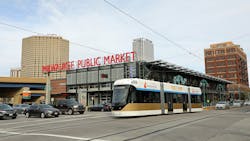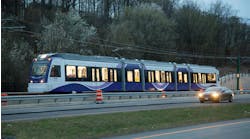Public transit is always focused on providing clean, efficient and, above all, safe transportation to its riders; and now, in the midst of a global pandemic, safety has come to the forefront and is being addressed in a more holistic way.
For streetcars and light-rail vehicles, this means considering how existing solutions can help mitigate the spread of COVID-19 while also buckling down on technology and safety improvements such as air filtration and remote capabilities. Although suppliers report there has not been much change to existing orders, they are already exploring new features that not only address concerns of today, but also anticipate what agencies and passengers will need in the future.
Ensuring Quality Air Flow, Cleanly Surfaces
The pandemic has spurred recent innovations to not only ensure surfaces are thoroughly cleaned, like applications with UV light, but also to improve the cycling of air within transit vehicles, such as solutions with advanced filtering integration.
At Siemens Mobility, the company is testing a new cleaning concept that provides continued air and surface treatment that has successfully removed COVID-19 particles in previous testing within ships and buses, explains Marc Buncher, president and CEO of Siemens Mobility in North America. This is incorporated into the HVAC systems and uses charged/ionized particle cleaning.
“[The technology] is referred to as Needlepoint Bipolar Ionization technology and it reduces the level of airborne particles, which can act as a transport mechanism for viruses, pathogens and bacteria by creating positive and negative ions,” said Buncher. “The technology is certified as ozone-free and 100-percent safe to humans.”
Siemens Mobility is also considering a heat treatment that would heat a car to 133 degrees in areas where there's enough time to cool down before it’s used again, and how it can use air flow simulation studies to better design equipment layouts to optimize air quality.
Noah Heulitt, vice president, Rolling Stock Business Development, Alstom North America, shares Alstom is also in discussions with its customers who have existing orders about how the design of certain systems, such as air flow and filtration, can be adjusted.
“[Additionally,] where many agencies have adopted UV lighting as part of cleaning operations, Alstom is actively investigating permanently embedded UV-C lighting within the interiors of rolling stock,” Heulitt said.
Bombardier Transportation is also improving its HVAC offerings with a new series of antiviral filters that capture virus carriers like water, dust and aerosols while eliminating the virus itself with a unique impregnation technology, explains Ian Hodkinson, head of Technical Sales and Marketing – Transit Systems, Americas Region, Bombardier Transportation. The filters are available in a range of sizes and thicknesses, allowing them to be integrated with existing HVAC systems or new car builds.
“Their effectiveness has already been tested in a laboratory environment and further pilot programs are ongoing,” Hodkinson said. “When combined with the frequent door openings and closures on light-rail vehicles and metro vehicles, passengers can feel comforted that every effort has been made to reduce and dilute airborne aerosols.”
Brookville Equipment Corporation Manager of Applications Engineering Jason Maher echoes these thoughts and mentions similar advancements, such as UV lighting and improved filtering integration, has been discussed with clients for the company's Liberty Streetcar offering.
Creating New Solutions to Address Renewed Safety Concerns
Outside of improved air quality, suppliers are rolling out additional applications to address pandemic concerns while also developing technology solutions to increase the overall safety of streetcars.
One way Alstom is addressing safety concerns as it relates to the pandemic is partnering with internationally recognized scientific institutions such as Bureau Veritas to develop a Healthier Mobility™ portfolio of ready-to-implement and in-development solutions.
“These solutions preserve health and limit the impact on the environment while maintaining equipment reliability, specifically in the domains of cleaning and disinfection; contact surfaces; air treatment and contactless passenger/transit interfaces and passenger density and flow,” said Heulitt.
Bombardier Transportation has also developed a set of new applications in response to the pandemic, which features a variety of retrofit kits for vehicle and operations teams that include hand sanitizer dispensers, Lexan partitions, as well as signage to help with social distancing and passenger flow as agencies start to see increased ridership.
“Our solutions have helped operators to increase capacity from 25 percent to 50 percent while still respecting social distancing,” said Hodkinson. “These kits can help maximize capacity while simultaneously maximizing passenger protection.”
However, mitigating the spread of viruses and bacteria isn’t the only safety concern. On a more technological side, Bombardier Transportation has also developed the Obstacle Detection Assistance System (ODAS) that can detect and track obstacles while warning the driver about potential risks. This can be installed on new vehicles or retrofitted onto existing fleets.
Utilizing Existing Safety Features in a New Age
While advancements in air filtration are taking off and new solutions are in development, it’s important to note several existing safety features, like video monitoring, automatic passenger counters and even seating materials, have a newfound purpose in the age of COVID-19. A year ago, these applications that once were security solutions are now helping agencies show customers the system is clean and sanitary.
“There are many existing technologies that we are being asked about that could help mitigate pandemic effects,” said Buncher.
Such features include automatic door opening, capacity monitoring and live video feeds—all of which were applicable prior to the pandemic for security purposes but can now help address social distancing and mask wearing compliance. Additionally, Buncher explains there’s a renewed interest in utilizing more remote capabilities, such as implementing software applications for remote maintenance and operations.
Alstom shares ithas several solutions that already enhance passenger hygiene, such as “hygienic grab poles painted with a specific powder paint that prevents the proliferation of bacteria and offers a permanent and efficient protection against contamination,” explains Heulitt.
Rethinking existing vehicle interiors is another way to enhance safety. For instance, Buncher says Siemens Mobility is seeing a renewed interest in hard seating since it is easier to clean and disinfect. And Heulitt shares Alstom expects to maintain passenger capacity with additional standing areas where possible.
“Our current Citadis Spirit, 100-percent low-floor product is a great example of how we can keep this spacing for passenger distribution rather than with a partial low-floor solution where space may be occupied by steps,” Heulitt said.
Alstom is also exploring integrating more touchless technology into its products based on customer requests.
BROOKVILLE shares it can work with agencies to make provisions for amenities like personal protective equipment dispensers and add onboard contactless fare collection to existing vehicle fleets. BROOKVILLE also has existing capabilities to provide agencies with real-time information to help with monitoring crowding levels.
“BROOKVILLE also offers real-time data connectivity, including GPS location, of its streetcar fleet to transit agencies and operators,” Maher said. “Pairing these data monitoring features with the automatic passenger counting system installed on the vehicles, an authority or agency would be able to provide real-time occupancy data via a web app for riders. This could help passengers make educated decisions on choosing to board a crowded car or wait for a less crowded car only minutes away.”
Solving Today’s Issues While Keeping an Eye to the Future
The pandemic has influenced new technology developments for streetcar and light-rail vehicles such as improved HVAC systems or contactless fare collection, has encouraged suppliers to rethink vehicle interiors like seating material and has emboldened agencies to repurpose existing applications to solve new health concerns.
“It seems likely that further public health and safety provisions will be an integral part of the design for future Liberty fleets,” Maher said.
As streetcars adapt, they will continue to help solve the last-mile obstacle, which Hodkinson says continues to be true in the age of COVID-19 where passengers believe surface transport is complementary to underground transport. Hodkinson adds enhanced safety features such as increased grade separation, signal prioritization and the ODAS are expected to further drive demand for this mode of transit.
“As we recover from the coronavirus pandemic, light-rail vehicles will continue to offer safe, reliable transit to communities and new light-rail vehicle transit projects will provide an excellent means to revitalize urban centers and stimulate economic growth,” Hodkinson said.
While considering what applications of these light-rail vehicles will look like now and how the pandemic will influence the industry, Heulitt notes the issues at hand prior to the pandemic will once again surface.
“Despite the current situation, industry and customers must think of not only the needs of today, but also what agency and passenger needs will be in the future,” Heulitt said. “Over the longer term, the transit industry will grow and the same preoccupations that passengers have today will persist in the future and incorporate a new normal: green and smart mobility, and health and safety.”
To address these continued preoccupations, Alstom says its Citadis X05 features improved dynamic performances for higher speed operations, lower operating costs due to reduced energy consumption and improved maintenance costs thanks to better access to components and health diagnostics with digital predictive and condition-based maintenance solutions.
The bottom line: While streetcar and light-rail features and amenities will evolve, the “basic benefits of light rail have not change,” Buncher said. “It takes cars off the road, it is better for the environment and is an effective, affordable mode of transportation, especially in an age when people need to start moving again.”

Megan Perrero | Editor in Chief
Megan Perrero is a national award-winning B2B journalist and lover of all things transit. Currently, she is the Editor in Chief of Mass Transit magazine, where she develops and leads a multi-channel editorial strategy while reporting on the North American public transit industry.
Prior to her position with Mass Transit, Perrero was the senior communications and external relations specialist for the Shared-Use Mobility Center, where she was responsible for helping develop internal/external communications, plan the National Shared Mobility Summit and manage brand strategy and marketing campaigns.
Perrero serves as the board secretary for Latinos In Transit and is a member of the American Public Transportation Association Marketing and Communications Committee. She holds a bachelor’s degree in multimedia journalism with a concentration in magazine writing and a minor in public relations from Columbia College Chicago.


